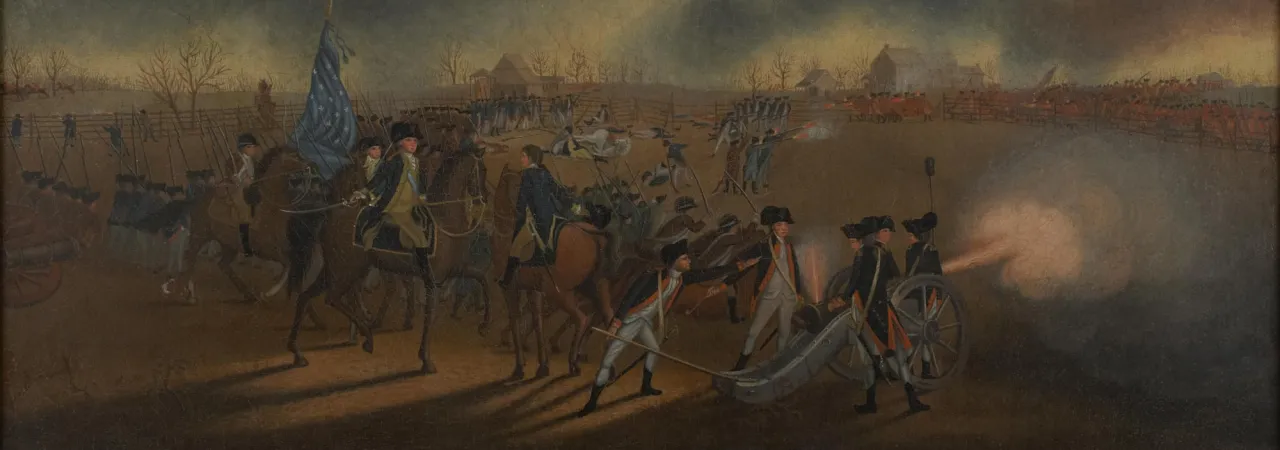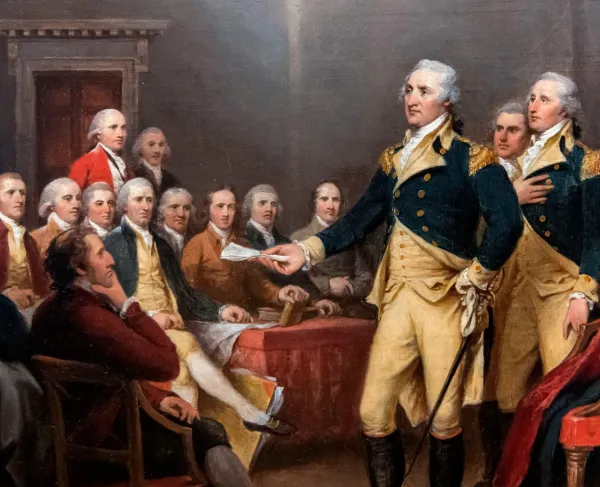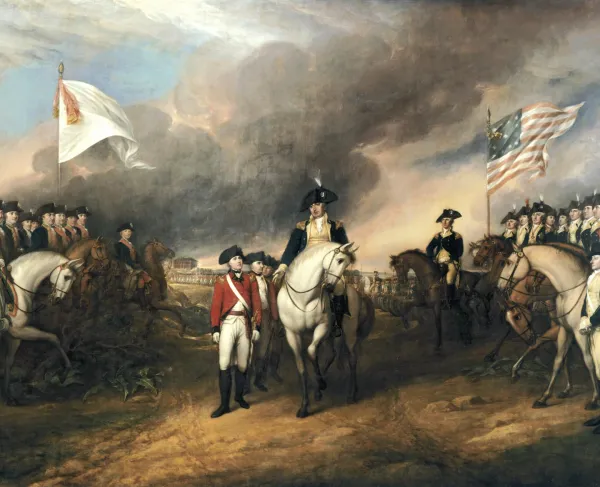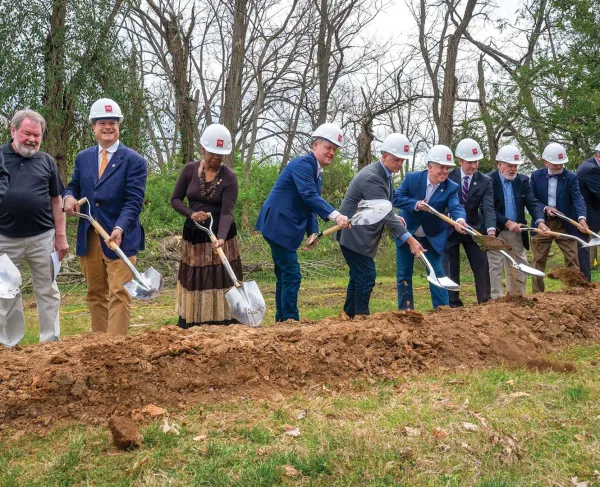
James Peale (1749-1831), The Battle of Princeton, ca. 1782,
As night fell on January 2, 1777 both armies took a breath after the daylong fighting on the King’s Highway and at Assunpink Creek. Washington had a critical decision to make, and called a council of war. Would the Continental Army stay on the south bank of the Assunpink Creek and let the British wear themselves down attempting to storm the bridge, or would the army withdraw to safety?
Washington was concerned about a British flanking move in the morning, one that could potentially trap the Continentals against the Delaware with no way to retreat. There was also the garrisons at Maidenhead (Lawrenceville) and Princeton to consider. After much deliberation, Washington made his decision; the army would make a bold night march, slipping away from the British at Trenton, and strike the garrison at Princeton. Again surprise, overwhelming numbers, and firepower, would win the day. If the Americans were lucky, they might even capture the major British base at New Brunswick, where the pay chests were rumored to be located.
The plan was a race; the Continental Army had to stay one-step ahead of Cornwallis and the main British force. Failure meant destruction by the larger, better trained, better equipped, British. Washington knew that a fair race would end in disaster, so a head start was needed.
After dark on January 2, Washington decided to steal a march on Cornwallis. A small force would stay at the Assunpink Creek, and convince the British that the Continental Army remained in place. Their job was to maintain the campfires, dig entrancements, occasionally lob a cannonball across the creek, and generally cause a ruckus.
While these men were at work, Washington would take the rest of the army by a secondary road towards Princeton. The plan was similar to the attack on Trenton: surround the town, cut the roadways to prevent escape, destroy the garrison, and capture their supplies. Speed was essential. The Continental army would outnumber the Princeton garrison roughly five-to-one, and would bring thirty-five cannon compared to the British’s eight.
By 2 AM, the Continental Army was on the road, slipping away from the unsuspecting British. They would march along Quaker Road, take a disused farm lane, Sawmill Road, and approach Princeton from the south. Continental Intelligence had provided Washington with a map of the defenses of Princeton, and Sawmill Road would allow a safer approach than the busier King’s Highway, which the British had fortified with earthworks and artillery emplacements.
Guarding Princeton was Lieutenant Colonel Charles Mawhood, in command of the reserve Fourth Brigade. With him were his own British 17th Regiment of Foot, 40th Regiment of Foot, 55th Regiment of Foot, a detachment from the 16th Light Dragoons, and a mixed unit of recruits and convalescents returning to their parent units. In total about 1,200 men, supported by a battery from the Royal Artillery with eight cannon. Mawhood had been ordered by Cornwallis to depart Princeton on January 3, and rejoin the main body at Trenton, an order that would change everything.
When Washington arrived at the intersection of Sawmill Road and Quaker Road, he divided his forces, much as he did at Trenton. A smaller force, under Brigadier Generals Thomas Mifflin and Matthias Alexis Roche de Fermoy, would continue up Quaker Road and seize the bridge over Stony Brook, located at the intersection with the King’s Highway. If possible, a detachment of this force would then continue to cut the roads north of town.
In the vanguard of Washington’s main body was Major General John Sullivan’s Division, behind them was Major General Nathanial Greene’s Division, these were the troops that had performed so well at Trenton and would again lead the attack. Behind the two veteran Divisions were the Philadelphia Associators under Brigadier General John Cadwalader, thwarted by the Delaware on Christmas Day, they were unable to participate in the Battle of Trenton, and were still green and untested. The entire force would continue down Sawmill Road to Princeton.
At daybreak, Washington’s main body was moving past the farms belong to the Clarke brothers, Thomas and William. One of his officers spotted a glint of light and a splash of scarlet on a rise, Cochrane’s Hill, across Stony Brook and raised the alarm. As Washington arrived, two British horsemen arrived on the hill, and then quickly disappeared. Soon thereafter a column of Redcoats appeared, marching at the quick step, back towards town. Both armies had spotted each other; in an instant, Washington’s plan was ruined. The battle had turned into a classic meeting engagement, where split second decisions could win or lose the battle.
Washington had a problem, he did not know if the British column was the entire garrison, or just a portion. His flank and rear were threatened by the column, but if he diverted his entire army the element of surprise would be lost. Washington made a snap decision; he would screen the main body as it continued into town and delay the British column.
Mawhood quickly identified the threat to his command, and his entrusted garrison; his solution was simple: attack. Sending his supply wagons ahead of his now reversed column, he sent the 40th and 55th to follow them and secure the town. At the Thomas Olden house, he deployed his 17th Regiment into line of battle, supported by the artillery and detachments. On either flank, were troopers from the 16th Light Dragoons, mounted on the left, and dismounted on the right.
Not knowing he was facing most of the British brigade, Washington sent Brigadier General Hugh Mercer’s brigade across the Clarke farms supported by two cannon under Captain John Neil. Mercer’s 300 men were an excellent screening force, made up of mostly riflemen they advanced towards a ridge and orchard near William Clarke’s farm. They took position along a fence on the edge of the orchard and waited.
Unfortunately for Mercer, his screening maneuver would soon turn into a pitched engagement. As Mercer entered the orchard a volley erupted from the far side, troopers from the 16th Light Dragoons had advanced ahead in a skirmish line. Their volley went high and the Americans responded with their own, to greater affect, and the Dragoons began to fall back.
Hearing the first exchange of volleys, Mawhood had his men drop their packs and dress their lines for battle. Advancing quickly, the British slammed headlong into Mercer’s men on the Orchard’s edge. A quick and brutal firefight erupted, with both sides exchanging volleys.
The initial British volley went high, and the American response was accurate and deadly, but the advantage soon edged towards the British. Even though both forces were about equal in numbers, the difference in equipment and training began to tell. Mercer’s riflemen lacked bayonets, and loaded slower than the muskets. While the accuracy of these weapons was deadly, particularly for British officers, their slowness and lack of bayonet made them almost useless in close quarters fighting. Seeing this weakness, Mawhood ordered a bayonet charge.
Across the valley, Cadwalader’s brigade was dressing their ranks around Thomas Clarke’s house. The intensity of the fire coming from William Clarke’s orchard proved that the British were attacking in force, and the American column was under dire threat. Greene, knowing that Mercer would need help, ordered Cadwalader forward, supported by Captain Joseph Moulder’s battery of four cannon.
The British bayonet charge broke Mercer’s men, who fled back towards Thomas Clarke’s house. Mercer tried to rally his men, but his horse was shot from under him. Surrounded by the British, who mistook him for Washington, Mercer was ordered to surrender, he responded by drawing his sword. Mercer was struck with a rifle butt and fell, then bayonetted seven times and left for dead; he died nine days later on January 12.
As Mercer’s men fled from the orchard, they passed through Cadwalader’s forming lines, throwing them into disarray. Some of Cadwalader’s men fled, others became disorganized in the confusion. The British now had an advantage, like so many battles before American morale was crumbling, and a slight push would shatter the army despite their superior numbers. Mawhood saw this advantage and pushed his men across the farm fields and towards the routing Continentals. If he could cut Washington’s column, the battle, and potentially the war, would be over.
Washington needed time. To the rescue came a few companies of Cadwalader’s men, and Joseph Moulder. Placing his battery on the shoulder of the ridge, Moulder’s guns loaded with grape and canister and unleashed on the British lines. Washington personally took command, and rode amongst Cadwalader and Mercer’s men rallying them by saying “parade with us my brave fellows! There is but a handful of the enemy, and we will have them directly.” Personally leading his reformed Continentals forward, Washington marched his men to within thirty yards of the British before giving the order to halt and fire. The British fired simultaneously.
Colonel John Fitzgerald, Washington’s aid-de-camp, feared that the General would be killed in the volley, and put his hat over his eyes so he would not have to see the broken body of Washington. When the smoke cleared, the British retreating, and Washington was unscathed.
The British withdrew to the ridge around William Clarke’s house and reorganized their ranks. More and more Continentals were pouring onto the field. In the center were Cadwalader and Mercer’s rallied men, to the left Mifflin’s brigade, on the right Hitchcock and Hand’s brigades supported by Frothingham’s artillery. As the American lines began to wrap around the British they could not withstand the overwhelming numbers. Some broke and ran, fleeing along Stony Brook; others withdrew in good order towards Princeton.
At the same time the drama on the Clarke farms was occurring, Sullivan’s vanguard was dealing with the 55th and 40th regiments. The 55th had deployed atop a hill, supported by artillery. Both sides warily eyed each other out of range, until the fleeing Redcoats from Mawhood’s main force convinced the 55th to withdraw. The 40th deployed in a strong position along Frog Hollow, a ravine and stream that cut the Sawmill Road. Sullivan massed his infantry and artillery and swept them aside, and they retreated towards Nassau Hall, where many surrendered.
After about an hour, the battle was over. Washington had demonstrated his ability to think quickly and adapt on the field, snatching victory from near defeat. For the first time, the Continental Army was able to break British regulars. Unlike Trenton, however, the victory was not total. A number of British soldiers escaped, as did much of the garrison’s supplies. Mawhood, unlike Rall, was praised for his intrepid defense and King George III himself decorated the 17th. Casualties for the engagement are difficult to discern. Estimates of British casualties stand at about 230, with another 250 captured. American losses number about 80.
The Americans held Princeton until midafternoon. Cornwallis, awaking to find Washington gone and hearing the sound of the guns in the distance, immediately set out towards Princeton. Washington’s army was exhausted, and in no condition to fight the main body of the British. The Americans withdrew, fighting a rearguard action at Stony Brook bridge, and then along the road until reaching the town of Kingston.
At Kingston, the Continental Army moved north to join other units encamped at Morristown, the British disengaged and moved back to their base at New Brunswick. Shortly thereafter, the British withdrew most of their forces from New Jersey, guarding the garrison at New York. In ten days Washington’s army had achieved the impossible, crossing the ice-choked Delaware three times, fighting three battles, and besting the British army at every turn. When the army arrived in Morristown on January 5, 1777 the entire war had changed, hope now reinvigorated the Americans, and a belief that they could indeed win the war.
Related Battles
75
270
5
905





